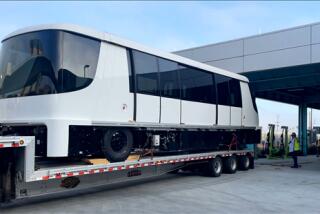LAX among worst offenders in runway close calls
The rate of close calls between aircraft on the ground approached record highs in recent years at Los Angeles International and airports around the nation, according to a government report released this morning. LAX also recorded one of the largest total numbers of serious runway incursions.
The findings come despite much-touted efforts by the Federal Aviation Administration and local airports to ensure that pilots and air traffic controllers follow federal rules that permit only one plane at a time on or near a runway.
LAX has been plagued by a series of close calls over the last 18 months, including one Aug. 16 in which two jets carrying 296 people came within 37 feet of each other. Among the nation’s most crowded airports, LAX is unusual because its layout requires that aircraft cross four parallel active runways. The crossings occur about 900 times a day.
The Government Accountability Office report is expected to heighten the debate about whether the airport should move apart two parallel runways on its north side. The FAA has long said such a shift would be the most logical solution to crowded conditions that contribute to close calls -- but neighboring residents fear it would bring air traffic dangerously close to their homes.
Nationwide, the GAO found that runway safety gains achieved earlier this decade have been eroded by overworked controllers, a jump in flights to pre-9/11 levels and a lack of leadership by the FAA.
The report, requested by the House Committee on Transportation and Infrastructure, is the harshest indictment in years of the FAA’s progress in addressing incidents in which aircraft violate safety zones around runways. The agency began a much-publicized effort in 2000 to curb close calls, which are considered the most serious threat to domestic aviation today.
Though GAO researchers applauded such FAA initiatives as enhancing lighting and signs on airfields, providing additional training for pilots and controllers and developing new radar systems, they found that the rate of runway safety violations in 2007 is nearly as high as its peak in 2001.
Even more concerning, researchers found the rate of the most serious close calls remained relatively steady from 2002 through 2006, suggesting “a high risk of a catastrophic runway collision occurring in the United States.”
In a statement responding to the report, the FAA said it had exceeded its goal for reducing the most serious close calls in 2007. It added that it was working with airport officials to identify measures to further reduce the incidents.
The union that represents the nation’s air traffic controllers said the report underscored the organization’s repeated attempts to press the FAA to hire more controllers.
“This report provides yet another credible, compelling and clear link between safety and controller fatigue, which is caused by staffing shortages and longer hours on the job,” said a statement by Patrick Forrey, president of the National Air Traffic Controllers Assn.
LAX, one of the nation’s busiest airports of the last seven years, has one of the highest total numbers and rates of close calls and those regarded as the most severe, GAO researchers found. The airport was the site of the country’s most well-known runway collision, in 1991, when a controller mistakenly placed a departing SkyWest commuter plane in front of an arriving US Airways jet. The accident killed 34 people.
FAA and LAX officials have acknowledged that early efforts to improve runway safety, including installing new ground radar systems and developing posters on airfield layout for pilots, had helped but are no longer that useful.
They are working on new ways to address the problem, including more advanced radar equipment and completing a $333-million project to move apart two parallel runways on the airport’s south side. This effort “will virtually eliminate serious runway incursions on the south airfield,” said Ian Gregor, an FAA spokesman.
But the new ground radar system, intended to eliminate blind spots and false alarms that hinder an existing collision-alert system, has been delayed repeatedly. The FAA expects to install it next year.
More to Read
Sign up for The Wild
We’ll help you find the best places to hike, bike and run, as well as the perfect silent spots for meditation and yoga.
You may occasionally receive promotional content from the Los Angeles Times.






